Looking Beyond the Clouds: Part 2
With a great deal of luck, a great employer, flexible client and a very, very encouraging wife I did make it back down for part 2 of the NASATweetup for STS-134. If you didn’t catch my first summary of my experience in part one you can go read it here. Once again, this post is NOT related to Cloud Computing, but there were clouds involved, both man made (smoke) and very natural (obscuring) ones.
Back to Florida…
On May 14th I flew back down to Florida. My client was really great in giving me some work that I could do remotely. That definitely helped take some of the pressure off the trip. I had made plans to be able to be there through Thursday (the 19th), but if the shuttle hadn’t launched by then I’d have to give up and return home. I had enough remote work to keep me reasonably busy so I could at least bill some hours and get some good work done.
I ended up staying at the same place as I did before in Daytona, even though it was quite a drive down to Kennedy Space Center (KSC), but the room was really good and wasn’t touched by the launch inflation factor the hotels around KSC had (some tripling their rates for the nights around launch).
I Get Close To a Space Ship!
I have to admit, the thing I was bummed most about from the first trip down was that we were stormed out of being able to go watch the Rotating Service Structure (RSS) retraction. It was cool being able to hide out from the storm in the NASA News briefing room, but I thought it wouldn’t have held a candle to seeing the Endeavour on her launch platform from 600 yards away. Boy, was I right.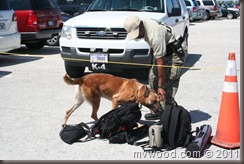
Sunday morning those persistent space geeks who returned for NASATweetup STS-134 part two gathered at the Press Site on the KSC Grounds. We were headed out to the pad, so security was pretty tight. We passed the sniff tests and were cleared to head out.
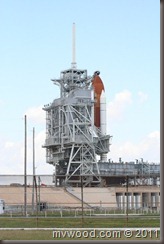 We took the little over three mile drive out to Launch Pad 39-A on two NASA tour buses. The press were taken out ahead of us, but put in a different location. When we got out to the pad the RSS was in place, shielding the orbiter from the weather and had allowed the service crews to complete the repairs to the Auxiliary Power Units that had caused the first scrub a few weeks before. We were taken to a roped off area with a side view of the launch pad, so as the RSS rolled back we would be the first to see the orbiter. From the zoomed out picture you can get a good idea of about how close we were. All of us filed out of the buses and started setting up cameras.
We took the little over three mile drive out to Launch Pad 39-A on two NASA tour buses. The press were taken out ahead of us, but put in a different location. When we got out to the pad the RSS was in place, shielding the orbiter from the weather and had allowed the service crews to complete the repairs to the Auxiliary Power Units that had caused the first scrub a few weeks before. We were taken to a roped off area with a side view of the launch pad, so as the RSS rolled back we would be the first to see the orbiter. From the zoomed out picture you can get a good idea of about how close we were. All of us filed out of the buses and started setting up cameras.
The RSS takes about 20 minutes to roll back completely, 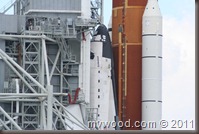 so at first there doesn’t seem to be much movement. Many of us were taking random shots at different intervals, taping the event or posting to Twitter about what was going on (this is a Tweetup after all). You could feel the excitement swell as soon as the first part of the orbiter came into view.
so at first there doesn’t seem to be much movement. Many of us were taking random shots at different intervals, taping the event or posting to Twitter about what was going on (this is a Tweetup after all). You could feel the excitement swell as soon as the first part of the orbiter came into view.
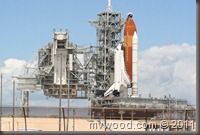 We spent about an hour or so out at the pad. We had our picture taken with the shuttle stack in the background. Then, sadly, it was time to head back to our buses. Thanks to a question by fellow Tweetup attendee Doug White we landed a great photo opportunity on the way back though. The tour guides stopped each bus at a stop sign for about five minutes so that we could get some really great straight on shots of Endeavour. The bus tilted pretty good when everyone jumped to one side to take pictures.
We spent about an hour or so out at the pad. We had our picture taken with the shuttle stack in the background. Then, sadly, it was time to head back to our buses. Thanks to a question by fellow Tweetup attendee Doug White we landed a great photo opportunity on the way back though. The tour guides stopped each bus at a stop sign for about five minutes so that we could get some really great straight on shots of Endeavour. The bus tilted pretty good when everyone jumped to one side to take pictures.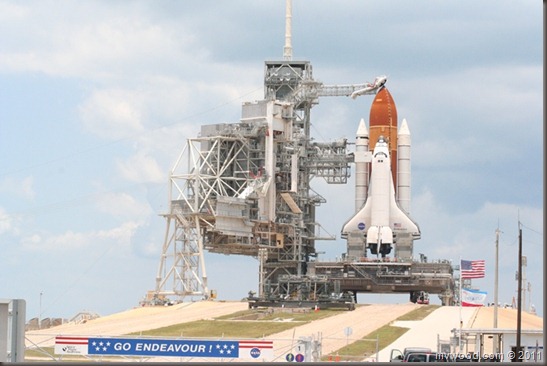
Up at O’Dark Thirty
The astronauts had been slowly adjusting their sleep cycles over the last several weeks so that they would stay in sync with the launch window. This meant that they went to bed about 4:00 PM on Sunday to get 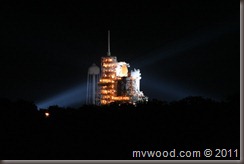 up at midnight to prepare for a 8:56 AM launch. It was highly encouraged that we get to bed early. We could be back at KSC at 3:00 AM when the employee gate opened. Since I had quite the drive from Daytona I did end up waking up about 1:00 AM (the hotel people had to clarify twice that I really did want that wake up call time).
up at midnight to prepare for a 8:56 AM launch. It was highly encouraged that we get to bed early. We could be back at KSC at 3:00 AM when the employee gate opened. Since I had quite the drive from Daytona I did end up waking up about 1:00 AM (the hotel people had to clarify twice that I really did want that wake up call time).
I got to the press site at about 3:20 AM and went to set up my tripod to stake out some ground. Driving in the Xenon lights shining out at the launch pad were really bright. A fellow attendee (Brian Prince, but not the one the regular readers of this blog probably know) let me use his 100-400L mm lens to take a photo of the pad (above). This was the type of lens I had almost rented when I went down the first time. Seeing the quality of the picture at the distance we were at I almost wish I had rented it. Not for the launch, which would have been really too zoomed in, but for some of the shots that he was able to get of the moon and such while I couldn’t get my lens to really capture the detail in that low light. I did get a couple of neat shots though.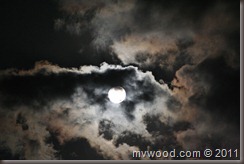
At about 5:00 AM we headed over to the Saturn Causeway road which leads out to the pad to watch the Astrovan drive by. This time it stopped only to let a few people out at Launch Control. A few of the attendees got a view of some of the astronauts inside when the door opened, but I had moved further down the roped off area and saw them waving through the darkened glass as they went by. They knew we were there all right. Some of the attendees had even brought “No U-Turn” signs to hold up as they went past given what happened last time.
Right after watching the crew head out to get strapped in and ready we went into the 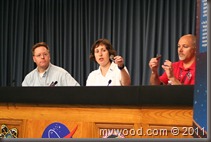 NASA News Briefing room and were given a presentation of the STORRM Navigational system that was being tested during this flight. A representative of Ball (the company producing the unit), a representative of Lockheed Martin (the people creating the Orion spacecraft) and two representatives from NASA Langley were on hand to talk us through what STORRM was, how it was going to be tested and what it could do. Once again, there is a tremendous amount of science taking place on every mission, always trying to improve designs and learn more to further our exploration of space. The data collected on this mission will help calibrate and space test a unit that may well be used for automated docking procedures in our next human based space craft.
NASA News Briefing room and were given a presentation of the STORRM Navigational system that was being tested during this flight. A representative of Ball (the company producing the unit), a representative of Lockheed Martin (the people creating the Orion spacecraft) and two representatives from NASA Langley were on hand to talk us through what STORRM was, how it was going to be tested and what it could do. Once again, there is a tremendous amount of science taking place on every mission, always trying to improve designs and learn more to further our exploration of space. The data collected on this mission will help calibrate and space test a unit that may well be used for automated docking procedures in our next human based space craft.
And then there was light…
After we came out of the briefing room the sun was finally starting to come up. At that point we were  giving pretty much our own time to hover around the press site (staying out of the way of the press). We didn’t have the tent we had before, but we took over
giving pretty much our own time to hover around the press site (staying out of the way of the press). We didn’t have the tent we had before, but we took over 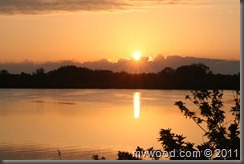 two sets of bleachers that had some power. I enjoyed a beautiful sunrise and then was saddened to see as we got close to launch time the clouds start to roll in.
two sets of bleachers that had some power. I enjoyed a beautiful sunrise and then was saddened to see as we got close to launch time the clouds start to roll in.
Finally, the time came. I had focused the camera and took out my remote shutter control. I turned on my cell phone’s video capture and just held it in the general direction of the pad. My goal was to watch the shuttle take off, if I got a decent shot then great. When the countdown hit zero you could see smoke come up over the trees and the shuttle started off the pad! The noise was…non-existent. The only sounds around me were cheers. At a little over three miles away the sound hadn’t reached us.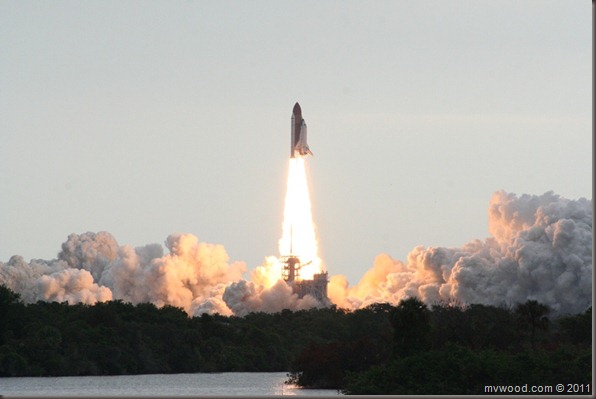
Once the shuttle got well off the ground you heard the first sounds from the launch several seconds earlier. A low rumble where the main engines had come online six seconds before T-zero. Then after that six seconds caught up to us you could hear the roar of the Solid Rocket Boosters. The sound was amazing. It rattled your chest and was loud enough even at three miles to not really allow conversation (not that any of us were doing anything other than cheering).
Sadly, the cloud cover quickly obscured the shuttle from our view pretty quickly. We could see the shadow of the shuttle in the clouds it continued it’s eight minute trip into orbit.
One Happy Geek
After the launch I hung out around the press site for about two hours to let traffic die off. Then, exhausted, I drove back to my hotel. The NASA Tweetup was an unbelievable experience the first time around when we didn’t get to see the launch. Being able to get back and actually see the historic final launch of Endeavour and be within a few hundred yards of her on the pad just defies description.
During a lull period while we were waiting someone had asked one of the organizers if she had a favorite shuttle. She replied yes, the Discovery. It was her first shuttle she saw launched, first shuttle she watched launched at night and a few other things that had made that specific shuttle special to her. She said that it was funny that even though the shuttles are primarily the same, everyone there had a favorite for one reason or another.
When I was reading about Endeavour I discovered that her maiden mission launched on May 7th, 1992. That date (not year) happens to be my birthday. Since this is the one and only shuttle I’ve ever seen launched, and I had such a great experience around this event, it’s safe to say that Endeavour is my favorite. Hopefully one day I’ll be able to see her again when she’s at the California Science Center in Los Angeles, CA, where she will be retired to after she lands in just a few short days.
You can find my complete picture gallery of the full event on my SmugMug site.
Also, they are having a NASA Tweetup around STS-135, the final space shuttle mission. Registration is June 1st and 2nd (2011 of course). If you use Twitter and have a passion for space travel, you really should put your name in the hat. It’s an awesome experience.